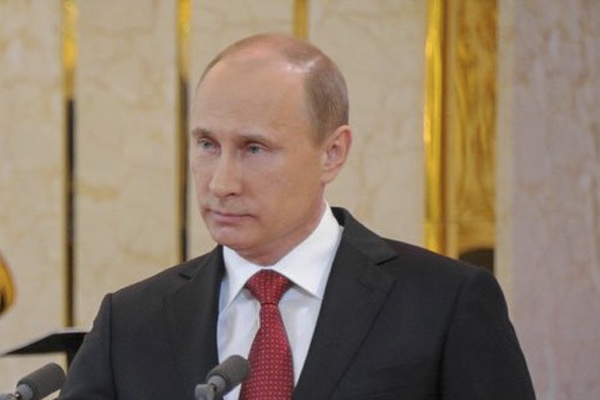Our Problem with Putin Is that He Sees the World Very Differently than We Do

"Vladimir Putin inauguration 7 May 2012-10" by Kremlin.ru. Licensed under CC BY 3.0 via Commons.
Vladimir Putin seems to be an enigma who brings out the worst in America’s leaders. He scores over 80 percent public support in Russia but is loathed by American leaders. At the G-20 summit in Russia in 2013 Obama called Putin a “jackass.” Deriding Russia as a regional power, Obama has more recently compared Putin to a kid who slouches in the back of the classroom. Hillary Clinton has compared Vladimir Putin to Adolph Hitler in seeking to redraw the boundaries of Europe. Even worse, Putin faces international sanctions, a massive decline in the fall of oil prices, sharp decline in the ruble and a sagging Russian economy.
Yet, in the Middle East Putin has skillfully built on the semi-withdrawal of the United States from the region, Sunni Arab perception of American weakness after the Iran Deal, and the massive conflagrations in Syria and Iraq. After being ousted from the region by 2010 (save for Syria), Russia has made a strong comeback. Russia has signed a two-billion dollar arms deal with Egypt, talked of selling two nuclear reactors to Jordan and strengthened its relationship with Israel. Putin is building an air base and sending several thousand soldiers to Syria, complementing but also challenging Iranian efforts to dominate the region.
In taking South Ossetia and Abkhazia from Georgia (2008), Crimea from Ukraine (20140 and now parts of the Left Bank from Ukraine (2015), Putin has shown himself to be a skillful leader in regaining much of Russia’s old influence in Eastern Europe.
American policy makers since the end of the Cold War have had difficulty in understanding Russian moves on the global scene.
Ever since the disintegration of the Soviet Union followed by the weak Yeltsin decade, Russian studies in the United States have gone into a steep decline as the country was seen as largely irrelevant to the world scene. In the 1990s there was a 55 percent decline in the number of students in Russian politics. Together with the decline of area studies and a fascination with numbers crunching and abstract models, the average age of Russian specialists has soared into the 50s and even 60s. A classic example is Zbigniew Brzezinski, the dean of Russia watchers, who is 86 years old.
For most Americans, history is a distant shore literally and figuratively. Since the British burned down the White House and Capitol in 1814, America has never been invaded by a foreign military. Not one of the top 50 colleges or universities require a single course in American history, let alone Russian history. Neo-isolationism has been a constant thread from George Washington’s Farewell Address in 1797, when he warned against entangling foreign alliances to the “American Firsters” of Charles Lindbergh in the late 1930s. The 40 years of Cold War internationalism ended in the late 1980s and Americans, unhappy with the wars in Afghanistan and Iraq, are ready for a partial withdrawal from the world. Americans, until recently, were future oriented, not past and historically oriented.
By contrast, history has been a powerful factor in Russia policy for over a thousand years. Russia has known numerous foreign invasions including the Mongol conquest (1240-1480), the Polish conquest of the Kremlin (1605), the Swedish invasion (1708), the French invasion (1812), the Crimean War (1853-1856) and smashing German victories in both World War I (1915-1917) and early World War II (1941-1942). With the disintegration of the Soviet superpower, Putin can play on the notion of a partial rebuilding of the Russian Empire in areas which remain populated by the 25 million Russians in the 14 non-Russian republics.
Similarly, the Middle East and Eastern Europe are adjacent to Russia or formerly part of the Soviet empire. They are near both historically and geographically. By contrast, the Middle East is 6,000 miles away from the East Coast and 8,500 miles away from the West Coast of the United States. Eastern Europe is 4,000 miles from the East Coast and 6,500 miles away from the West Coast.
Too, Putin can also play on religion. In the United States, while the great majority have some religious affiliation, religion is not formally a part of any policy. In Russia, religion is very important with Russian Orthodoxy strongly associated with the state and only four officially sanctioned religions (Orthodoxy, Islam, Judaism and Buddhism).
To truly understand Putin’s continuing probing at the periphery with his conservative nationalism Americans need to contemplate a world often defeated, quite religious, far away and wrapped up in its history, all traits alien to the modern and liberal United States in 2015.